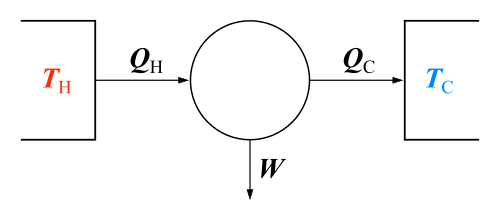Internal pressure
| Thermodynamics | ||||||||||||
|---|---|---|---|---|---|---|---|---|---|---|---|---|
The classical Carnot heat engine | ||||||||||||
|
Branches |
||||||||||||
|
||||||||||||
| Book:Thermodynamics | ||||||||||||
Internal pressure is a measure of how the internal energy of a system changes when it expands or contracts at constant temperature. It has the same dimensions as pressure, the SI unit of which is the pascal.
Internal pressure is usually given the symbol . It is defined as a partial derivative of internal energy with respect to volume at constant temperature:
Thermodynamic equation of state
Internal pressure can be expressed in terms of temperature, pressure and their mutual dependence:
This equation is known as the thermodynamic equation of state for it expresses pressure in terms of thermodynamic properties of the system.
Derivation of the thermodynamic equation of state The fundamental thermodynamic equation states for the exact differential of the internal energy: Dividing this equation by at constant temperature gives:
And using one of the Maxwell relations: , this gives
Perfect gas
In a perfect gas, there are no potential energy interactions between the particles, so any change in the internal energy of the gas is directly proportional to the change in the kinetic energy of its constituent species and therefore also to the change in temperature:
.
The internal pressure is taken to be at constant temperature, therefore
, which implies and finally ,
i.e. the internal energy of a perfect gas is independent of the volume it occupies. The above relation can be used as a definition of a perfect gas.
The relation can be proved without the need to invoke any molecular arguments. It follows directly from the thermodynamic equation of state if we use the ideal gas law .
Real gases

Real gases have non-zero internal pressures because their internal energy changes as the gases expand isothermally - it can increase on expansion (, signifying presence of dominant attractive forces between the particles of the gas) or decrease (,dominant repulsion).
In the limit of infinite volume these internal pressures reach the value of zero:
,
corresponding to the fact that all real gases can be approximated to be perfect in the limit of a suitably large volume. The above considerations are summarized on the graph on the right.
If a real gas can be described by the van der Waals equation of state
it follows from the thermodynamic equation of state that
Since the parameter is always positive, so is its internal pressure: internal energy of a van der Waals gas always increases when it expands isothermally.
The Joule experiment
James Joule tried to measure the internal pressure of air in his expansion experiment by isothermally pumping high pressure air from one metal vessel into another evacuated one. The water bath in which the system was immersed did not change its temperature, signifying that no change in the internal energy occurred, the internal pressure of the air was equal to zero and the air was a perfect gas. The actual deviations from the perfect behaviour were not observed since they are very small and the specific heat capacity of water is relatively high.
References
Peter Atkins and Julio de Paula, Physical Chemistry 8th edition, pp. 60–61
